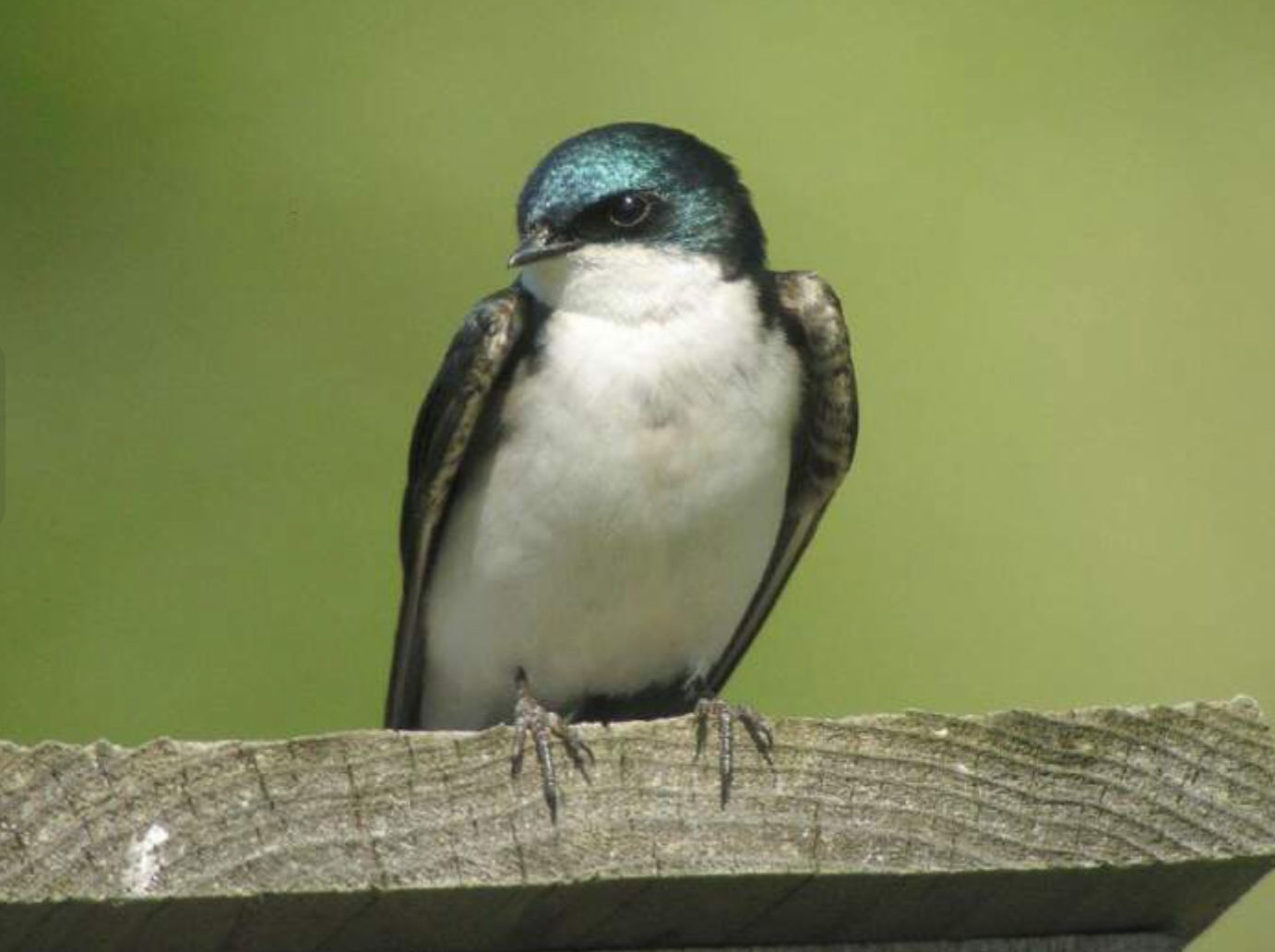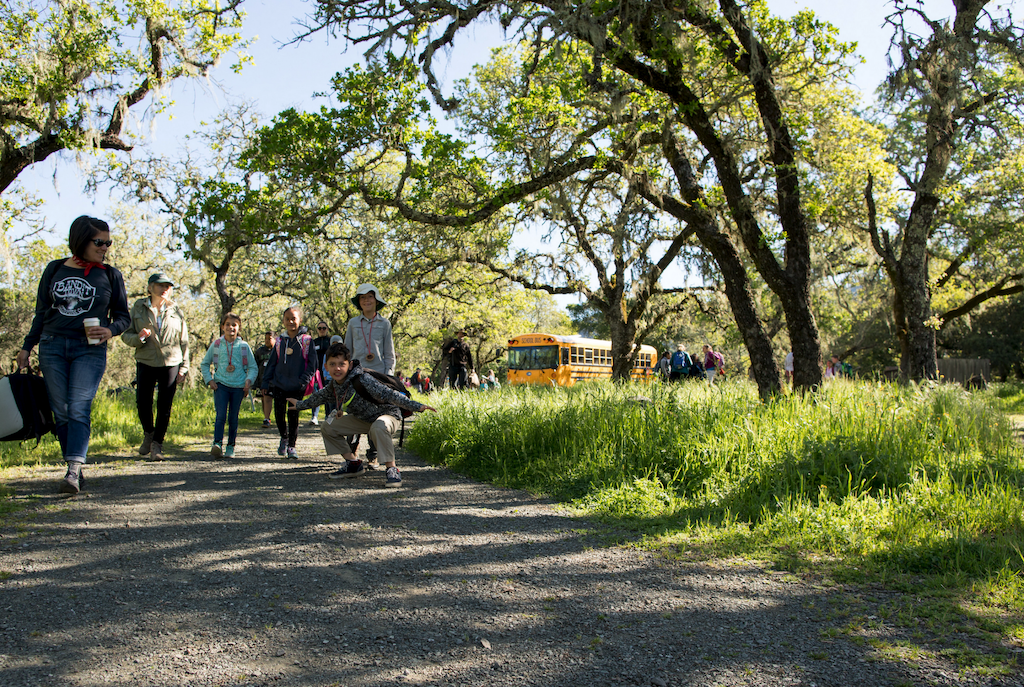Jeanne Wirka for THE PRESS DEMOCRAT
It’s Spring Madness out there as Sonoma County’s songbirds swoop into the full-court press of their breeding season. Bird song and other breeding behavior is as astonishingly complex as it is beautiful to behold. Fortunately, one need not be an ornithologist or even an amateur birder to appreciate this annual avian spectacle. Becoming familiar with just a few of our local feathered friends makes any outdoor adventure that much more meaningful and even mind-blowing.
Two birds that are easy to recognize, fun to watch, and fairly ubiquitous in our local parks and open space areas right now are western bluebirds (Sialia mexicana) and tree swallows (Tachycineta bicolor).
Another closely-related swallow — the brilliantly colored violet-green swallow (Tachycineta thalassina) — is less commonly seen, in part because it flies so fast and so high, although if you do get a good look, it will take your breath away.
All three are cavity-nesters that share similar habitat, and all have adapted readily to human-provided nest boxes. As a result, we actually know quite a bit about their private lives and how they interact with each other.
Western bluebirds
Few common birds have as devoted a human following as bluebirds. Perhaps it is their ability to stop you in your tracks with a flash of brilliant blue wing. Perhaps it is their generally chill demeanor combined with an easy-to-watch habit of perching relatively low and swooping to the ground to snag an insect. I suspect their popularity is at least in part due to the fact that people have learned to help these birds survive through the deployment and monitoring of nest boxes. Conservation success stories this intimate are hard to come by and here is one in which we can all participate, literally in our own backyards.
The western bluebird is found throughout the American west and in our area is a year-round resident. During the winter months in our oak woodlands, bluebirds can be found hunkered down in clumps of oak mistletoe, munching on its sugar-rich berries. So important is this seasonal resource, whole families of western bluebirds will claim and defend a mistletoe patch. In her acclaimed 2014 book “Secrets of the Oak Woodlands” (Heyday, $18), local author and naturalist Kate Marianchild explains that mistletoe even determines family structure of bluebirds in the wintertime. Researchers found that when mistletoe clumps were removed from an area, the male offspring in the family left the area.
Bluebirds are considered “socially monogamous,” which means they form strong long-term pair bonds, which may last their entire lives. However, these pair bonds are somewhat fluid — up to 25 percent of bluebird young in a given nest have a different daddy. Nevertheless, family life among bluebirds is relatively stable and cooperative. At the end of summer, female offspring will move in with another family while new “daughters-in-law” move in with her birth family. While most songbirds drive off their young as soon as they can forage for themselves, bluebird parents keep their sons and daughters-in-law around, even though that means more competition for food. It turns out that some of these hangers-on — especially the sons and brothers from the previous year — help the breeding pair raise their young. Indeed, sometimes breeding bluebird pairs will raise their own family while at the same time helping to feed and defend the offspring of their relatives. Ultimately, bluebirds who cooperate end up having more young and living longer than those who go it alone.
Throughout their range, populations of western bluebirds have been relatively stable over the past 50 years, although some local populations have declined precipitously. The primary threats to their ongoing survival is loss of habitat and competition from non-native birds like the house sparrow and European starling. As cavity-nesters, bluebirds look for old woodpecker holes or crevices in mature trees and snags. Naturally, there is competition for such prime real estate, especially in light of deforestation and humans’ habit of tidying up by removing dead branches and snags (remember even a dead tree is somebody’s home). To mitigate these losses, humans have stepped up across North America to build, monitor and maintain nest boxes (for more information, see below). Of course, just as there is competition for naturally occurring nest sites, nest boxes in our area are in high demand from multiple local species, especially bluebirds and tree swallows. This leads to some fascinating bird behavior.
Two local swallows
Swallows are the aerial acrobats among songbirds, and the tree swallow is among the most beautiful. With dark blue-green iridescent backs and bright white fronts, both males and females are quite fetching in their colorful “tux and tails.” Tree swallows have long pointed wings, allowing them to soar and swoop and turn swiftly in pursuit of their primary prey—flying insects. Many an early evening, I have been mesmerized by tree swallows above the field by my house, careening about with their bills wide open, skimming insects from the air. Unlike western bluebirds, which are a resident species, tree swallows are migratory, spending their winters in Mexico, Florida and other southern locales. Each year, I wait in anticipation for that first flash of bright wing in February or early March, indicating the tree swallows have returned.
Closely related to the tree swallow is its striking cousin the violet-green swallow (Tachycineta thalassina). For those with a quick eye, violet-greens can be distinguished visually by their white cheeks and “saddlebags,” a purple rump, iridescent green back and a longer, slightly forked tail. All swallows are experts at catching insects in flight (called “hawking”), but tree swallows and violet-greens differ slightly in their strategies. When a tree swallow takes to the air, it may careen about above our heads, swooping and turning sharply. Or, it may cruise close to the surface of a pond, wetland, or even swimming pool, especially during cooler morning and evening hours. Either way, they are relatively easy to watch. Violet-greens also hunt over water but can be found at much higher altitudes as well, taking advantage of large swarms of free-floating prey. They are also very, very fast. At 28 mph, a violet-green’s fastest speed clocks in at the typical traveling speed of a peregrine falcon. Even with binoculars, I find it nearly impossible to keep up.
Tree and violet-green swallows are otherwise quite similar in their lifestyle. Both are cavity- nesters and both will happily nest in a nest box. To the chagrin of some bluebird-lovers, tree swallows can be quite aggressive in claiming, defending and even stealing nest boxes. One local resident reported seeing a pair of tree swallows remove a bluebird from a nest box by each taking one bluebird wing in its beak, and hustling it off like a pair of bouncers. As comical as these antics are to watch, this intense competition does sometimes result in destruction of eggs and even killing of baby birds. Nest box watchers have reported that sometimes neighborhood harmony between tree swallows and bluebirds can be achieved by simply placing a second nest box near the first.
My favorite story of swallow-bluebird interaction, however, is one of cooperation not competition. Violet-green swallows have been observed actually assisting bluebird families raise their young, bringing food and even removing the fecal sacks (think tiny packets of poop) of the bluebird babies from the nest. All this in a neighborly attempt to hasten their fledging and to call “dibs” on the nest site once the bluebirds are gone. How cool is that?
About nest boxes
If you’d like to bear closer witness to the fascinating lives of these local birds, or even become a citizen scientist nest monitor, consider installing one or more nest boxes. While there are myriad sources of information online, I recommend first visiting the NestWatch website at nestwatch.org. NestWatch is a joint project of the Cornell Lab of Ornithology and the Smithsonian Migratory Bird Center which trains citizen to monitor all types of nests around the country.
Check out their “all about birdhouses” for instructions on how to build or purchase the best type of nest box for the birds you want to house, where to locate the boxes, and how to prevent predators or invasive species from trespassing.




